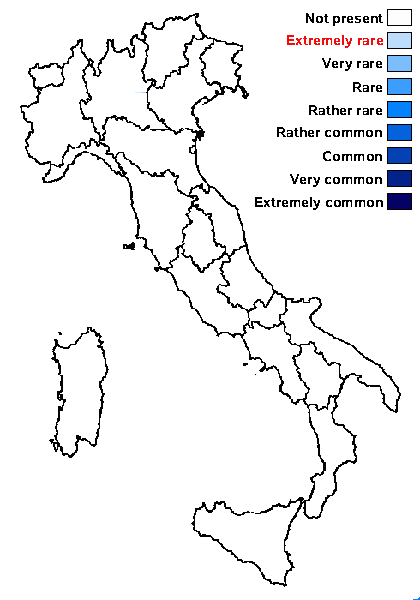Atla recondita Savić & Tibell
Lichenologist, 47: 97, 2015
Synonyms:
Distribution:
Description: Thallus crustose, very thinly episubstratic, ochraceous brown. Perithecia black, 0.28-0.37 mm across, subspherically projecting, with a depressed periostiolar area. Involucrellum blackish brown, 42-80 µm thick (thicker in apical part); exciple poorly delimited from the involucrellum, pale in upper part, pale brown at base; hamathecium of slender, c-1.5 µm thick and 28-48 µm long, septate, apically sparingly branched pseudoparaphyses, interascal filaments absent; hymenial gel hemiamyloid, I+ red (I+ blue at very low concentrations of I), K/I+ blue. Asci 8-spored, broadly ellipsoid to clavate, K/I-, fissitunicate, without apical thickening at maturity. Ascospores muriform with 9-15 transverse septa and 3-4 longitudinal septa, remaining hyaline for a long time (sometimes turning yellowish when overmature), ellipsoid, 41-49 x 19-23 µm. Photobiont chlorococcoid, the cells 8-9.5 µm wide; additional cyanobacteria often associated with the thallus. Spot tests: K-, C-, KC-, P-, UV-. Chemistry: without lichen substances.Note: an apparently rare species growing on calciferous rocks in open situations, often along watercourses. Described from Scandinavia and recently reported from Austria (Styria, see Breuss 2022) . To be looked for in the Italian Alps.
Growth form: Crustose
Substrata: rocks
Photobiont: green algae other than Trentepohlia
Reproductive strategy: mainly sexual
Periodically submerged (e.g. in creeks)

Predictive model
Growth form: Crustose
Substrata: rocks
Photobiont: green algae other than Trentepohlia
Reproductive strategy: mainly sexual
Periodically submerged (e.g. in creeks)

Predictive model

